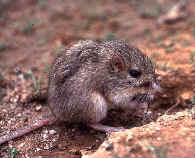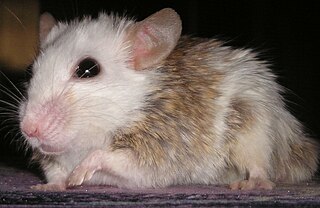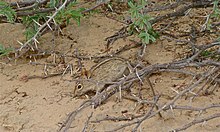
The Muroidea are a large superfamily of rodents, including mice, rats, voles, hamsters, lemmings, gerbils, and many other relatives. Although the Muroidea originated in Eurasia, they occupy a vast variety of habitats on every continent except Antarctica. Some authorities have placed all members of this group into a single family, Muridae, due to difficulties in determining how the subfamilies are related to one another. Many of the families within the Muroidea superfamily have more variations between the families than between the different clades. A possible explanation for the variations in rodents is because of the location of these rodents; these changes could have been due to radiation or the overall environment they migrated to or originated in. The following taxonomy is based on recent well-supported molecular phylogenies.

The Muridae, or murids, are the largest family of rodents and of mammals, containing approximately 1,383 species, including many species of mice, rats, and gerbils found naturally throughout Eurasia, Africa, and Australia.

The Nesomyidae are a family of African rodents in the large and complex superfamily Muroidea. It includes several subfamilies, all of which are native to either continental Africa or to Madagascar. Included in this family are Malagasy rodents, climbing mice, African rock mice, swamp mice, pouched rats, and the white-tailed rat.

The Old World rats and mice, part of the subfamily Murinae in the family Muridae, comprise at least 519 species. Members of this subfamily are called murines. In terms of species richness, this subfamily is larger than all mammal families except the Cricetidae and Muridae, and is larger than all mammal orders except the bats and the remainder of the rodents.

Tankwa Karoo National Park is a national park in South Africa. The park lies about 70 km due west of Sutherland near the border of the Northern Cape and Western Cape, in one of the most arid regions of South Africa, with areas receiving less than 100 mm of average annual precipitation, moisture-bearing clouds from the Atlantic Ocean being largely stopped by the Cederberg mountains. Other low areas receive little more, as the Roodewerf station with 180 mm of mean annual rainfall. In the hottest areas of the park, the mean maximum temperature in January is 38.9 °C, and in July the mean minimum temperature ranges from about 5 to 7 °C. Before this Park's proclamation, the only protected area of Succulent Karoo was the 2 square kilometre patch of the Gamkaberg Nature Reserve. Succulent Karoo has, together with the Cape Floral Kingdom, been declared a Biodiversity Hotspot by Conservation International.

The black harrier is a medium-sized African harrier whose range extends from South Africa to Botswana and Namibia. It has a wingspan of 105–115 cm (41–45 in) and a body length of 44–50 cm (17–20 in). When perched, this bird appears all black. However, in flight a white rump and flight feathers become visible. Its morphology is comparable to that of other harriers, with a slim body, narrow wings and a long tail. Male and female plumages are similar. Juveniles have buff under-parts and heavily spotted breasts.

The desert pocket mouse is a North American species of heteromyid rodent found in the southwestern United States and Mexico. True to its common name, the medium-sized desert pocket mouse prefers sandy, sparsely vegetated desert environments.

Lemniscomys, sometimes known as striped grass mice or zebra mice, is a genus of murine rodents from Africa. Most species are from Sub-Saharan Africa; L. barbarus is the only found north of the Sahara. They are generally found in grassy habitats, but where several species overlap in distribution there is a level of habitat differentiation between them.

Acanthosicyos horridus is an unusual melon that is endemic to the Namib desert. In English it is known as Nara, butter-nuts, or butterpips; in one of the Khoisan languages it is locally called ǃnaras or ǃnara.

The southern multimammate mouse or southern African mastomys is a species of rodent in the family Muridae which is endemic to southern Africa. It is called a multimammate mouse because it can have 8 to 12 pairs of mammae, in comparison other mouse species only have 5 pairs.
The Ethiopian striped mouse or striped-back mouse is a species of rodent in the family Muridae. It is only found in Ethiopia. It was formerly classified in the monotypic genus Muriculus, but phylogenetic evidence supports Muriculus being a subgenus within Mus, the true mice. The Ethiopian striped mouse's natural habitats are subtropical or tropical high-altitude grassland and urban areas. It is threatened by habitat loss.

The Southern African vlei rat is a species of rodent in the vlei rat genus, Otomys, of the family Muridae in the order Rodentia. This is the type species of the genus. It is native to the grasslands and swamps of southern Africa where it is a common species.

The bush vlei rat or Karoo bush rat is a species of rodent in the family Muridae. It is found in Namibia and South Africa. Its natural habitat is temperate shrubland. The Karoo rat uses behavioral adaptations to cope with the dry arid climate. It is a medium-sized rodent with a dark pelage on top and lighter underneath. It has light colored feet and a dark tail. The rat may have light colored fur around its eyes and the back of its ears.

The four-striped grass mouse or four-striped grass rat, is a species of rodent in the family Muridae.

The mesic four-striped grass rat is a species of rodent in the family Muridae.

The ALX3 gene, also known as aristaless-like homeobox 3, is a protein coding gene that provides instructions to build a protein which is a member of the homeobox protein family. This grouping regulates patterns of anatomical development. The gene encodes a nuclear protein that functions as a transcription regulator involved in cell-type differentiation and development.

Arvicanthini is a tribe of muroid rodents in the subfamily Murinae. Almost all recent species in this tribe are or were found in Africa aside from one species, the Indian bush rat, which is found in South Asia and Iran. However, some fossil Golunda species from India and the genus Parapelomys are thought to have also occurred outside Africa, and one species in the fossil genus Saidomys may have also occurred in Afghanistan.
















